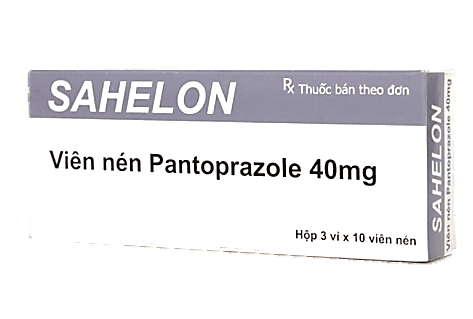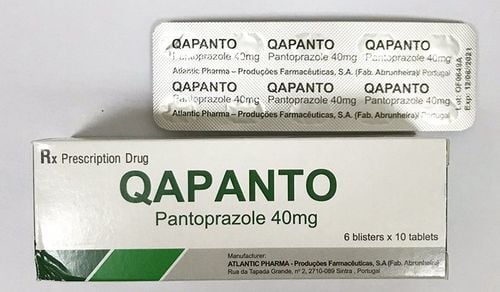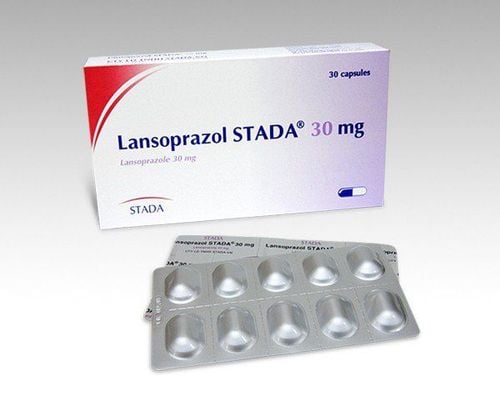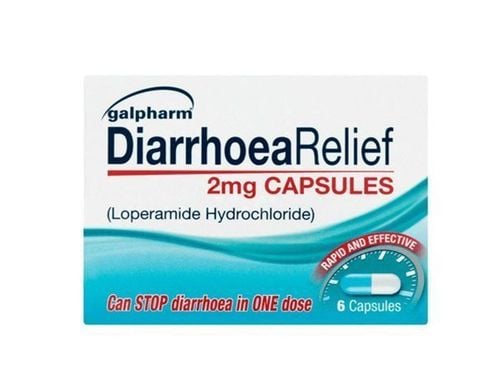This is an automatically translated article.
Softprazole contains Esomeprazole magnesium dihydrate which belongs to the class of proton pump inhibitors (PPIs). Softprazole is commonly used in the treatment of cases of gastroesophageal reflux disease - oesophagitis, peptic ulcer disease, Zollinger - Ellison syndrome... Learn basic information such as ingredients, uses, and uses. , dosage and side effects of Softprazole will help patients improve treatment results.1. What is Softprazole?
Softprazole drug is prepared in the form of enteric coated tablets under 2 concentrations, Softprazole 20mg and Softprazol 40mg, with the main ingredients including:
Active ingredients: Esomeprazole (in the form of Esomeprazole magnesium dihydrate) 20mg and 40mg. Excipients: Just enough for 1 vial of powder for injection. Mechanism of action: Esomeprazole magnesium dihydrate is the S-isomer of Omeprazole, so it has similar effects as Omeprazole in the treatment of gastroesophageal reflux disease, peptic ulcer disease and Zollinger-Ellison syndrome. . Esomeprazole has a specific inhibitory mechanism on the enzyme H+/K+-ATPase, therefore this compound belongs to the class of proton pump inhibitors, which block the final step in acid production and reduce acid secretion at the cell surface. wall cells of the stomach.
Proton pump inhibitors such as Esomeprazole magnesium dihydrate have inhibitory effects on Helicobacter pylori but do not eradicate this bacterium, so it must be combined with antibiotics such as Amoxicillin, Tetracycline or Clarithromycin in the treatment of H. pylori infection.
2. What are the effects of Softprazole?
Softprazole is indicated for the treatment of the following cases:
Gastroesophageal reflux disease (GERD). Maintenance treatment of gastroesophageal reflux disease (GERD) in the convalescent phase. Progressive peptic ulcer disease. Combination with antibiotics in the treatment of Helicobacter pylori infection. Zollinger-Ellison syndrome. Prophylaxis of gastric ulcers caused by the use of non-steroidal anti-inflammatory drugs (NSAIDs). Prevention and treatment of peptic ulcers caused by stress. Prophylaxis of recurrent bleeding after endoscopic treatment of gastric and duodenal ulcers. Support in the treatment of bleeding caused by peptic ulcer disease.
3. Contraindications of Softprazole
Hypersensitivity to any ingredient of Softprazole. History of allergy to other medicines containing Esomeprazole magnesium dihydrate. History of allergy to other drugs of the gastric proton pump inhibitor (PPI) class. Pregnant women or women who are breastfeeding.
4. Dosage and how to use Softprazol
Note: Take the medicine at least 1 hour before eating.
Dosage
Adults or adolescents ≥ 12 years old
Stomach - duodenal ulcer with benign progression: Take 20mg/time in the morning. Duration of treatment: 4-6 weeks or longer depending on the patient's response. Gastroesophageal reflux disease (GERD): Take 20-40mg once daily for 4 to 8 weeks. It is possible to continue treatment for another 4 to 8 weeks if the lesion has not healed. Zollinger-Ellison syndrome: Initial dose is 40mg twice daily, then increase or decrease dose as necessary. The dose can be increased to 80-160mg/day, doses greater than 80mg/day must be divided into 2 times. Treatment of H. Pylori infection: Use a regimen of Esomeprazole (Softprazol) 20mg x 2 times a day or 40mg x 1 time a day + Amoxicillin 1g x 2 times a day + Clarithromycin 500mg x 2 times a day. Duration of treatment for 7 days. Prophylaxis of stomach ulcers caused by non-steroidal anti-inflammatory drugs (NSAIDs): 20mg/time for 4-8 weeks. Do not change the dose of Softprazole in patients who are elderly or have impaired renal function. Children:
Softprazole is not recommended because clinical safety is not guaranteed.
5. Notes when using Softprazol
Treatment with Softprazole drug with high dose or prolonged, may cause side effects such as:
Common: Systemic disorders such as dizziness, dizziness, headache, skin rash. Digestive disorders such as Nausea, vomiting, flatulence, dry mouth, abdominal pain, diarrhea, constipation. Uncommon: Systemic disorders such as rash, pruritus, paresthesia, fatigue, insomnia, somnolence, visual disturbances. Rare: Systemic disorders such as fever, diaphoresis, photosensitivity, alopecia, peripheral edema, hypersensitivity reactions such as urticaria, angioedema, bronchospasm, anaphylaxis. Central nervous system disorders such as agitation, depression, confusion, hallucinations. Respiratory infection. Hematologic disorders such as leukopenia or leukopenia, pancytopenia, thrombocytopenia. Liver dysfunction such as hepatitis, jaundice, impaired liver function, increased liver enzymes. Taste disorder, stomatitis. Metabolic disorders such as hyponatremia, porphyria, hypomagnesaemia. Musculoskeletal symptoms such as muscle pain, joint pain, osteoporosis, fracture. Skin symptoms such as Stevens-Johnson syndrome, toxic epidermal necrolysis, dermatitis, bullous rash. Other signs such as interstitial nephritis, gynecomastia in men. The drug should be stopped as soon as the above symptoms are detected after taking Softprazole and promptly notify the medical staff or immediately go to the nearest medical facility for timely treatment.
Note the use of Softprazole in the following subjects:
It is necessary to exclude malignancies such as stomach cancer before using Softprazole for patients. Softprazole should be used with caution in patients with gastrointestinal infections, patients at risk of fracture due to osteoporosis. Pregnancy: According to the US Food and Drug Administration (FDA) there are no safety data on the use of Softprazole in pregnant women. Therefore, Softprazole is contraindicated in this subject. Lactation: There are currently no studies showing whether the active ingredient Esomeprazole magnesium dihydrate contained in Softprazole can be excreted in breast milk. Therefore, to ensure the safety of nursing infants, the use of Softprazole is contraindicated in this subject. Drivers or workers who operate machinery may experience side effects such as dizziness, dizziness, hallucinations, etc. while working. Therefore, avoid using Softprazole before and during work.
6. Softprazole drug interactions:
Interactions with other drugs:
Softprazole reduces the absorption of antifungal drugs such as Ketoconazole or Itraconazole. Avoid using Softprazole at the same time with drugs such as Delavirdine, Posaconazole, Nelfinavir, Erlotinib because it can increase the side effects of both drugs. Softprazole reduces the concentration and effect of the following drugs: Atazanavir Clopidogrel Dabigatran Etexilate Dasatinib Erlotinib Indinavir Iron salt Mesalamine Mycophenolate Nelfinavir Softprazole drug increases the concentration and effect of the following drugs: CYP2C8, CYP2C19 substrates Methotrexate Saquinavir Voriconazole Above is an overview of ingredients, indications, contraindications, dosage and precautions when using Softprazole. Note, Softprazol is a prescription drug, patients need to use the drug as prescribed by the doctor, absolutely do not self-treat at home.













